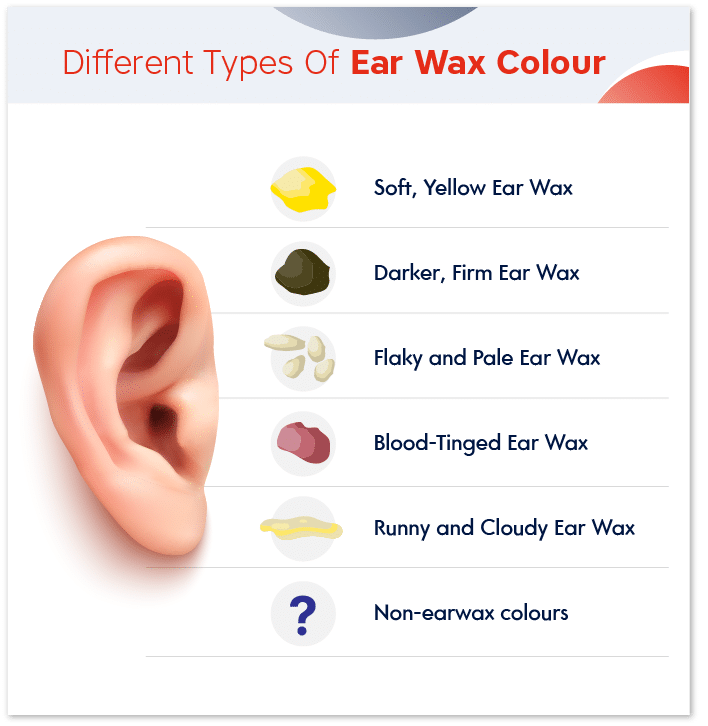Before discussing the colour of ear wax, it’s important to understand what ear wax is and the functions that it performs.
For such an important substance, ear wax has a bit of an unfair reputation. Ear wax plays a key defence mechanism for the health of your ears. It helps to clean and lubricate the ear canals, while also preventing dust, dirt and other debris from entering the ear canal.
Why Do We Have Ear Wax?
Ear wax, or cerumen, is formed in the outer third of the ear canal and is a mixture of secretions from oil and sweat glands, as well as dust, dirt, hair and dead skin cells.
Generally speaking, the ears are self-cleaning. The wax moves out of the ear canal by a mixture of jaw movement and the motion of a superficial skin layer. When it reaches the external ear it falls out naturally, and any remnants can be wiped away.
Everyone has different ear wax, and it is your genetic background that dictates what type of ear wax you have.

Wax can be either wet or dry, depending on genetics. Wet wax (honey coloured sticky wax) is more common amongst Caucasians and Africans, where dry wax (white/grey and flaky) is more common in those of Asian descent. This same gene also impacts on sweat production – if you have wet wax you are more likely to have body odour!
Different Types of Ear Wax and Colours
Let’s look at some common earwax colours:
- Soft, yellow ear wax: Newer ear wax is commonly this colour, and this is usually a sign of healthy ear wax production as your wax isn’t hardening too much before it falls out.
- Darker, firm ear wax: This is a sign of older earwax that may have hardened. If you notice this coloured wax and are suffering from wax related symptoms, it may be a sign of an impaction, and you should have your ears checked by a professional.
- Flaky and pale ear wax: Earwax tends to become flaky and pale as it heads to the outer third of the ear canal and combines with shedding skin. This is an indication of a healthy self-cleaning mechanism taking place within your ear.
- Blood-tinged ear wax: This is an indication of some injury to the ear, like a scratched canal or even trauma. It can also be a sign of improper wax removal techniques. In fact, very few home ear wax removal techniques are safe. You should let your wax naturally fall out and wipe away any visible remains from the outside of the ear. Using fingers, cotton tips, candles (or any other objects in the ears) may just push wax further into the ear and cause potential damage.
- Runny and cloudy: If you notice cloudy ear wax that has a runny texture, may or may not have an offensive smell, and you have associated symptoms of pain or itching, you should visit a health professional. . This is often not wax but rather secondary debris related to a bacterial or fungal external ear infection which may need to be treated with prescription ear drops. Keep the ear dry and seek medical advice.
- Non-earwax colours: on occasion, foreign bodies do become stuck inside the ear canal. Items such as dislodged hearing aid domes, insects, bits of paper and plastic, stickers, blu tac etc. can become trapped in the ear canal and require manual removal. Again, this should be checked by an earwax removal professional.
Do You Have Questions About Your Ear Wax?
The colour of your ear wax can tell you a lot about your ear’s health, but it is always recommended that you see a trained professional if you are worried about your ears or have symptoms of a blockage.
An appointment with award-winning Earworx will include a consultation and examination of your ear canal to assess whether you are suffering from impacted ear wax and would benefit from a professional clean. The Registered Nurse will thoroughly examine your ears to assess whether or not wax removal is clinically indicated. The entire process is gentle and pain-free, and if you are suffering from an impacted or blocked ear, you may feel almost instant relief.
Make an Appointment Today
You can make an appointment at one of our clinics online. Visit our clinics tab for information on clinic locations and contact details.
For more information click here to view or download the Earworx brochure.
